牛津译林版高中英语必修三Unit3BacktothepastPeriod2教案
- 格式:doc
- 大小:91.00 KB
- 文档页数:4
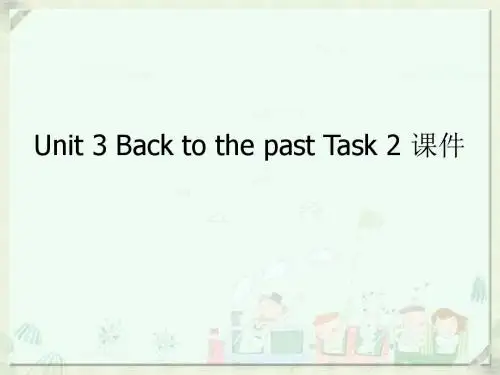

Unit 3 Back to the past ProjectMaking a poster about a historical figureTeaching Aims:●To learn the passage●To help students to understand the history by looking at the famous people who played keyroles in history.●Make a poster about a historical figure.Teaching Procedure:Step One: Lead- inAsk students what do they think of the sentence that the circumstances create heroes and what do you know about Alexander the Great and the father of Western philosophy.1. What do you think of the sentence that “The circumstances create heroes”?2. Do you know Alexander the Great? If so, what do you know about him?Show them the pictures of Alexander the Great and the father of Western philosophy.Step Two: Reading the article about Ancient Greek statue found in Xinjiang1. Fast reading. Ask students to gain the main idea for each paragraph.2. Detailed reading. Help stu dents to get detailed information about Alexander the Great by asking questions.Step Three: Reading the article about the father of Western philosophy1.Ask them read the article and get the main idea for each paragraph.2.Ask them more questions about the father of W estern philosophy.Step Four: Language PointsShow some useful expressions and explain the usage of these words and phrases.1. When asked how…no doubt this was a result of Alexander the Great’s influence.no doubt 无疑,确实e.g. He’s made some great movies. There’s no doubt about it.他拍了一些非常出色的影片。

模块3 unit. 3 Period two 教案Word powerTeaching objectives:1.D evelop the students’ ability to use the target language in real situation.2.E nlarge the students’ vocabulary by learning some words about archaeology.3.Help the students grasp the use of some commonly used pair nouns and group nouns.●Teaching methods:1.Students-centered.2.Teacher and students’ interaction3.Multimedia way.●Teaching procedurePart A . Teach the pair nouns and group nounsStep 1. lead in•Situation: Ann: I saw a group of people all try to take onepair of binoculars.•Jane: Why ?•Ann: All of them wanted to be the first to get aclose look at Mount VesuviusHelp the students to get the idea about pair nouns and group nouns by looking at some pictures.. a pair of sacksa flock of birdsa herd of horsesStep 2. Label each picture, using an expression including a word in the box.Then summarize the use of pair nouns.•The word pair is used for many things that are found in twos or have two parts. It is placed in front of the plural form of a noun.Step 3. Label each picture, using an expression including a word in the box.Then summarize the use of group nouns.• A group noun is used to refer to people or things as a group.•We can also use the words family, crowd and team to refer to people who appear collectively.Step 4. competition.Now let’s have a competition and see how much you know about group nounsand pair nouns?Step 5. ActivityPlease describe the following events with the pair nouns and group nouns that we have learned.●In the Zoo●The National DayPart B. Learn some words and information about archaeology.Step a picture of a famous archaeologist and ask questions.Who is he ?What is he ?Where is he?What is he doing?Step each picture, using an expression and words and information about archaeologyStep 3 Students read Part A carefully, paying attention to the word in blue.Step 4 Students read and fill in the blanks of Part B.Step 5 Students have a group discussion•Which s ubject are you interested in?•What are you going to be when you grow up?Step the students to write out as many words about the subject as possible.Task 3. Homework1.Remember the pair nouns and group nouns.2.Preview the grammar.Grammar and usage (1)---- object complementTeaching objectives:. To understand what is object complement2. To know what structure can be object complement3. To make sure what words can be followed by object complement and how they are followedStep 1Read the instru ctions of object complement on page 48, illustrate what structure can be object complement Step 2 Do the Exercise on page 48, at the same time illustrate what words can be followed by object complementStep 3 Practice1 Parents don’t allow us _________ in the adv enturous activities.A to participateB participateC participatingD participated2 I had great trouble ________ Tom’s house for I had forgotten his address.A findB findingC to findD found3 The street lights and the lights of passing cars made the clothes hung on the desk ________ on the shape of wildanimals.A takeB to takeC takingD taken4 With all the trees along the road ________, the blind lady was not able to feel her way back home.A removedB to removeC removingD remove5 _________ so many people away or ill, the meeting has to be put off.A WithB ForC AsD Because6 The baseball players _________ each other the best of luck in the match before it began.A wishedB hopedC expectedD wanted7 Some companies have ________ the manufacturing(加工) of clean and safe products their main sailing point andemphasize it in their advertising.A takenB madeC gotD cause8 The terrible noise from the next room simply _______ me out of mind.A droveB putC causedD turn ed9 The telegram message about his father’s illness ______ him hurrying back home.A. droveB. madeC. sentD. got10 The exchange students found ________ hard to get used to the food of the host family.A veryB howC itD thatGrammar and usage (2)----Subject-verb agreementTeaching aims:. To understand what Subject-verb agreement is2. Different forms serve in different situationsTeaching steps:Step1Explain what Subject-verb agreement isStep 2 Different forms serve in different situationsA组依照意义一致1 Steam and ice _____ different forms of water. (is/ are)2 Trial and error _____ the source of our knowledge. (is / are)3 What he says and does _____ not agree. (does/ do)4 What he says and does _____ concern me. ( does/ do)5 The government _____ spent more than two million yuan for planting trees. (has / have)6 The city government _____ different opinions about next year’s plan. (has/ have)B组依照形式一致7 Neither I nor he _____ in favor of her marriage. (am/ is)8 Either you or I ______ going to be in charge of this matter. ( is/am)9 Not only the students but also the teacher _____to watch the game. ( wants/ want)10 Tom as well as two of his parents ______ invited to the party. (was/were)1 Dr. Smith, together with his wife, _____ to arrive on the evening night. (is /are)12 Nobody but one teacher and three students ______ in the lab. (was/ were)13 About two thirds of the surface of the earth ______ covered with water. (is / are)4 About 40 percent of the students in our school ______ girls. (is/ are)15 Each of the students _____ a copy of Jay’s new album. (has/have)16 The students each ____ a copy of Jay’s new album. (has/ have)17 The new kind of cars ____ now on show. (is /are)8 A number of students ____ from the south. (are/ is)19 The number of students from the north ____ (is / are) small.20 Huge quantities of oil _____ spilling into the sea. (was/were)21 A large amount of water _______ wasted every day in the south for they think water there is more than enough.( is/are)22 Those who ____ to go to the cinema must be at the school gate by 3:30 . (want/ wants)23 He who ___________ the great wall is not a true man. (does not reach/ don’t reach)24 She is the only one of the girls who ____ been to Beijing. (have/ has)25 He is one of the boys who ____ seen the film. (have/has)Step 3 Practice26 We live day by day, but in the great things, the time of days and weeks _____ so small that a day is unimportant.A isB areC has beenD have been27 A survey of the opinions of expe rts _____ that three hours of outdoor exercise a week _____ good for one’s health.A show; areB shows; isC show; isD shows; are28 The government has realized that the future welfare of its citizens ______ education.A is linked toB are linked toC links toD linked to29 With more forests being destroyed, huge good quantities of earth _____ each year.A is washing awayB is being washed awayC are washing awayD are being washed away30 Protecting the environment while developing economy _________ the very important thing the governmentstresses.A isB areC will beD was。
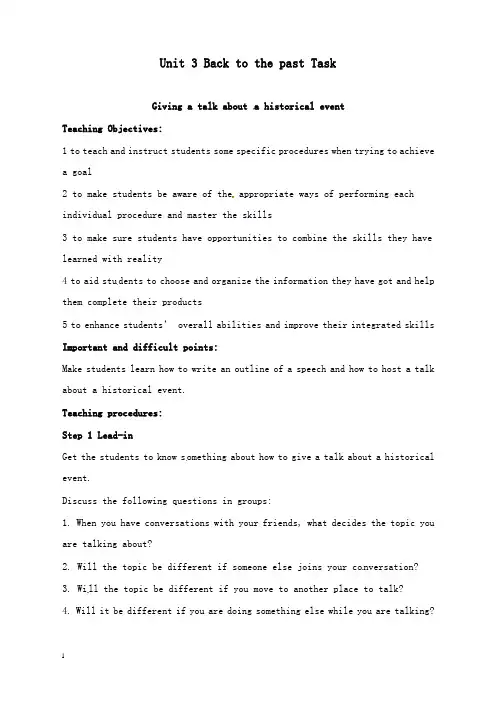
Unit 3 Back to the past TaskGiving a talk about a historical eventTeaching Objectives:1 to teach and instruct students some specific procedures when trying to achievea goal2 to make students be aware of the appropriate ways of performing each individual procedure and master the skills3 to make sure students have opportunities to combine the skills they have learned with reality4 to aid students to choose and organize the information they have got and help them complete their products5 to enhance students’ overall abilities and improve their integrated skills Important and difficult points:Make students learn how to write an outline of a speech and how to host a talk about a historical event.Teaching procedures:Step 1 Lead-inGet the students to know s omething about how to give a talk about a historical event.Discuss the following questions in groups:1. When you have conversations with your friends, what decides the topic you are talking about?2. Will the topic be different if someone else joins your conversation?3. Will the topic be different if you move to another place to talk?4. Will it be different if you are doing something else while you are talking?Step 2 Skills building 1Make students know how to listen to get the main ideas, and do the listening on P52. In step1, students use the skill to listen to a conversation and find the useful expressions.When we are listening to get the main ideas of something, we should tr y to find out:1.how many people are talking2. where they are3. what they are doing4. what they are talking aboutFinish the listening.Step 3 Skills building 2Make the students how to describe pictures and try to write a description of a historical place. In step 2, write a description about the Attack on Pearl Harbor according to the information found on a website.1. How would you describe a picture?2. From an audience’s point of view, what do you want to know most when seeinga picture?3. How do you decide whether a description is good or not?When we are describi ng a picture, we should pay attention to:• Do not point out every detail.• Briefly mention the picture’s subject.• Focus on the related background information about it.Step 4 Skills building 3Make students know what a simple outline of a speech often includes and organize some notes into an outline for a speech. In step 3, plan an outline to introduce their illustration and give their talks.Homework1.Write a passage about the Grand canal in about 150 words according tothe information given on P1132.Preview Project.。
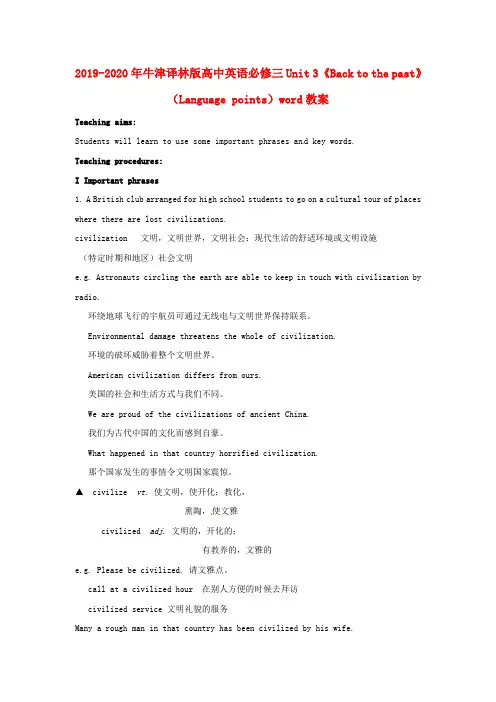
2019-2020年牛津译林版高中英语必修三Unit 3《Back to the past》(Language points)word教案Teaching aims:Students will learn to use some important phrases an d key words.Teaching procedures:I Important phrases1. A British club arranged for high school students to go on a cultural tour of places where there are lost civilizations.civilization 文明,文明世界,文明社会;现代生活的舒适环境或文明设施(特定时期和地区)社会文明e.g. Astronauts circling the earth are able to keep in touch with civilization by radio.环绕地球飞行的宇航员可通过无线电与文明世界保持联系。
Environmental damage threatens the whole of civilization.环境的破坏威胁着整个文明世界。
American civilization differs from ours.美国的社会和生活方式与我们不同。
We are proud of the civilizations of ancient China.我们为古代中国的文化而感到自豪。
What happened in that country horrified civilization.那个国家发生的事情令文明国家震惊。
▲ civilize vt.使文明,使开化;教化,熏陶,使文雅civilized adj.文明的,开化的;有教养的,文雅的e.g. Please be civilized. 请文雅点。
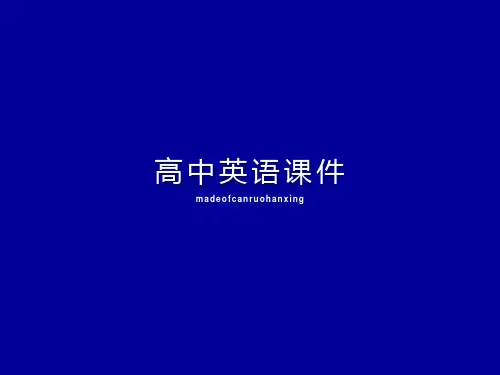
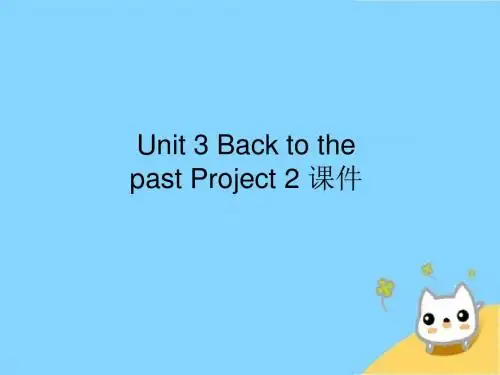

牛津译林版高中英语必修三Unit 3 B ack to the pastWelcome to the unitTeaching Objectives:1)Get students to conduct a free discussion about ancient civilizations.2)Encourage the students to share their ideas with each other.Important points and difficult points:1)Students are expected to describe what they have known about the ancientcivilizations.2)Encourage the students to communicate with classmates.Teaching procedures:Step1 Lead inAnswer Questions•Do you like traveling? Why ?•Where have you been ?•Will you please tell us something about your trip?•The May Day holiday is coming . Where will you go on your holiday ?Task One•My foreign friend John wrote a letter to me and said his students had formed a group called “ civilization trip” and they were going to visit China during the May Day holiday. He asked me to recommend 4 places where they could get the most. Now will you help me to find four best places and make a brief introduction for them.•Before doing it, please answer the following questions.•Do you know what is civilization about ?•What are the foreign students want to know?•What are the four best places you think we should recommend?Step2 Talking about the picturesThe Statue of Zeus:Who is Zeus? (A god of Greek mythology, Cronus and Rhea’s youngest son, the supreme ruler of both Mount Olympus and the Pantheon of gods residing there) What does the name Zeus mean? (It is said to be related to the Greek word ‘dios’, with ‘bright’ as its meaning.)Where was the Statue of Zeus once located? (On the western coast of Greece) The Taj Mahal:Who built it? (Shah Jehan, the fifth Mughal Emperor.)For whom and why was it built? (It was built by Shah Jehan for his beloved wife as a monument of eternal love.)When was it built? (From 1631 to 1648)Where is it? (On the banks of India’s most sacred river, the river Yamuna in Agra)The Hanging Gardens:Who built it? (King Nebuchadnezzar, who ruled ancient Babylon for dozens of years)Why did it appear to be ‘hanging’in the sky? (It looked so because it was constructed entirely on the roofs of a building, with a lot of trees surrounding it.) Why was it built? (To cheer up Nebuchadnezzar’s wife who was said to be very homesick)The Potala Palace:Where is it located? (On the Red Hill in the Lhasa Valley of Tibet, China)When was it rebuilt? (In the 17th century)What was it used as? (The residence of the Dalai Lamas since the 7th century, as well as the religious and political centre of old Tibet)Step3 Group discussion•People from ancient civilizations built many magnificent structures. Some of them have disappeared, while others remain today.•Do you think it is important to protect cultural heritage? Why or why not ? Do you have any suggestions on how to protect it?Step 4 InterviewHow do we protect our cultural heritage, in your opinion?Step 5 Competition•Cultural heritages is very important . There are many places in our country have been in the world heritage lists. Please name them as many as you can while looking at the following pictures.•Let’s see which group will win.Step 6 Homework : Preview reading.。
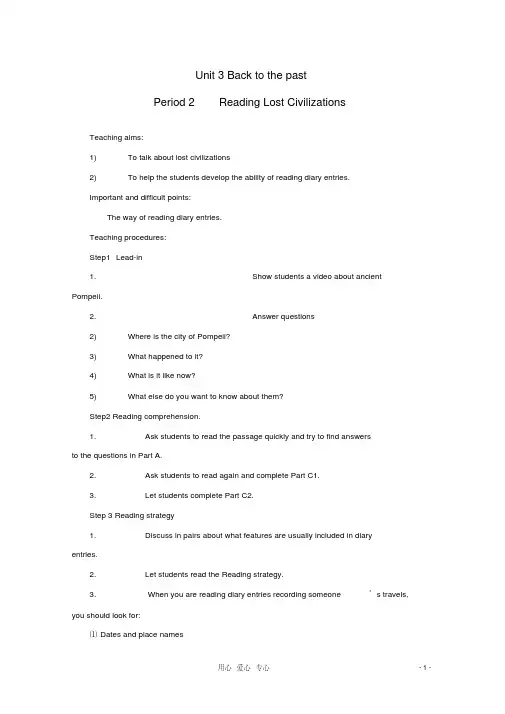
Unit 3 Back to the pastPeriod 2 Reading Lost CivilizationsTeaching aims:1) To talk about lost civilizations2) To help the students develop the ability of reading diary entries.Important and difficult points:The way of reading diary entries.Teaching procedures:Step1Lead-in1. Show students a video about ancient Pompeii.2. Answer questions2) Where is the city of Pompeii?3) What happened to it?4) What is it like now?5) What else do you want to know about them?Step2 Reading comprehension.1. Ask students to read the passage quickly and try to find answersto the questions in Part A.2. Ask students to read again and complete Part C1.3. Let students complete Part C2.Step 3 Reading strategy1. Discuss in pairs about what features are usually included in diary entries.2. Let students read the Reading strategy.3. When you are reading diary entries recording someone’s travels, you should look for:⑴ Dates and place names⑵Facts and historical information⑶Personal feelings and opinions4. Answer questions according to the text.1 What happened to Pompeii in August AD 79?2. How was the buried city discovered?3. What were the stepping stones along the road in Pompeii used for?4. Why was Loulan an important city about 2,000 years ago?5. How do many people think Loulan disappeared?6. According to the last sentence, how d id the author feel about the loss of Loulan?5. Find out the facts and historical information about the two cities.Pompeiitime event in the 8th centuryin 89 BCon 24th Aug. AD 79in 1860Loulan2000 years agofrom AD 200 to AD 500100 years agoStep 4 Discussion1. Is it useful for people to study things from the past? Why or whynot?2. Since as long ago as 1553 people have said, ‘History repeats itself.’ What do you think this saying means? Do you agree with it? Why or why not?Step 5Homework.1. Read the passage carefully and review the new words and phrases.2. Make a summary of the text.Period 3 Reading (2)Teaching Objectives:1) To understand the text better2) To master some useful words and expressionsImportant and difficult points:Some useful words and expressionsTeaching procedures:Step 1 Check the homework.Step 2 Complete the summary with proper words.Both Pompeii in ________and Loulan in China became ____ ________ about 2000 years ago. Pompeii was ________ in the 8th century BC and was _____ _______ by the Romansin 89BC. On 24th Aug.AD79, Mount Vesuvius _________ and the city were _______ __________. Loulan was a _________ _________ on the Silk Road. It disappeared under the ________. There are just a few _________ left. Some _________, such as coins and painted pots,was found.Step 3 language study? 1. A British society arranged for ten high school students fromdifferent countries to go on a cultural expedition to sites of lost civilizations.arrange v. 安排,筹划,整理,布置? arrange + n. + for + n. 为…安排…? arrange + for + n. + to do 安排…做…? arrange + (with + n.) + to do (与人)约定干…? arrange + that clause(从句用should + v.) 商定…, 安排…?I arranged to meet him at 6 o’clock.?我约定在6点钟跟他见面.? The secretary ______ ______ themanager.?秘书替我向经理预约.?I’ve _______ for him ________ her.?我已安排他跟她见面.? He arranged that the meeting _______ off for a week.?他安排把会议延后一星期召开.? 2. I am representing Canada. I feel lucky to have won a place on this trip.?我代表加拿大。
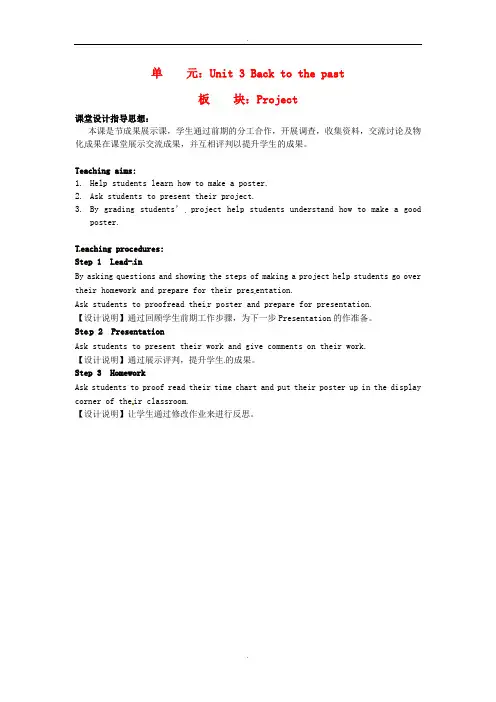
.单元:Unit 3 Back to the past板块:Project课堂设计指导思想:本课是节成果展示课,学生通过前期的分工合作,开展调查,收集资料,交流讨论及物化成果在课堂展示交流成果,并互相评判以提升学生的成果。
Teaching aims:1.Help students learn how to make a poster.2.Ask students to present their project.3.By grading students’ project help students understand how to make a goodposter.T eaching procedures:Step 1 Lead-inBy asking questions and showing the steps of making a project help students go over their homework and prepare for their pres entation.Ask students to proofread thei r poster and prepare for presentation.【设计说明】通过回顾学生前期工作步骤,为下一步Presentation的作准备。
Ste p 2 PresentationAsk students to present their work and give comments on their work.【设计说明】通过展示评判,提升学生的成果。
Step 3 HomeworkAsk students to proof read their time chart and put their poster up in the display corner of the ir classroom.【设计说明】让学生通过修改作业来进行反思。

高中英语Unit3BacktothepastTask教学设计2牛津译林版必修3单元: Unit 3 Back to the past板块: Task讲堂设计指导思想:经过进一步演练学习描绘历史事件并展现成就。
Teaching aims:(用英文撰写)详细陈说本课时要做的事及其目的,要从学生学习的角度陈说,如:1.Aid students to choose and organize the information they have got and help themcomplete their products.2.Enhance students ’ ove rall abilities and improve their integrated skills.3.Make students learn how to write an outline of a speech and how to host a talkabout a historical eve nt.Teach ing procedures:Step 1 Lead inIntroduce the topic of Pearl Harbour.【设计说明】经过导入检查学生对珍珠港背景知识的认识程度。
Step 2 Writing descriptions for your illustrationsFollow the steps on pages 55-56.Step 3 Giving your talkani ze students into small groups and choose some sets of illustrations.2.Plan an outline according to a set of illustrations.3.Give the talk in groups and pay attention to the points given on P57.Step 4 HomeworkAsk students to write their speech.【设计说明】经过家庭作业再次稳固所学内容。
单元:Unit 3 Back to the past板块:Welcome to the unit课堂设计指导思想:本课通过了解世界文化遗产,拓展学生的人文知识,培养学生人文素养。
通过一系列课堂活动,激发学生用英语了解,描述,表达世界文化遗产,同时为下一课作好铺垫。
Teaching aims:1.Stude nts will be asked to talk about some magnificent structures, including theStatue of Zeus, the Taj Mahal, the Hanging Gardens and the Pltala Palace.2.Students are required to get involve d in the discussion, practise their spokenEnglish and participated in all the designed activities.3.Students are expected to be able to describe one of the ancient civilizationsand develop their sense of culture protection.Teaching procedures:Step 1 Introduction1.The teacher starts the lesson with the song Rivers of Babylon and introduce thetopic.2.Arouse students interests by introducing the seven wonders of the world andintroduce the topic by asking questions “Why are they called the seven wonders of the world?” and“ What other ancien t civilizations do you know about?”【设计说明】通过学生感兴趣的音乐话题引入主题。
单元: Unit 3 Back to the past板块: Reading堂指思想:通听写、翻、造句、替、填空、完句、情形、故事(用所操的言点故事)等活操言点。
Teaching aim s:Master some language items.Teaching procedures:Step 1 Practice of language it ems1. similar: be similar to⋯the same⋯as/that⋯be different from⋯the similarity of a cat to a tigerMary is similar to Rose in many ways.The two cats are similar but not the same.1) Although ______ in appearance, the two plants have some basic differences.2) The song ____________ the one I heard yesterday.3) A second study produced ______ r esults.2. take over1) After his father retired, he took over th e c ompany.2)I took over her job while she was in New York.3)Our company was recently taken over by a larger one.3. so was the city1)I felt excited, ______ did the others.2)I didn ’t feel excited, _________ did the others.3)I ’ve never been to London, neither/ nor have my parents.4. with1)With so many trees around, our sc hool ⋯2)With so much homework to do⋯3)With everyt hing finished⋯4)With the old man showing the way⋯5)With a book in his hand⋯5. asas 引状从句,表示依据,依据,正如的意思。
模块3 unit. 3 Period two 教案Word power●Teaching objectives:1.D evelop the students’ ability to use the target language in real situation.2.E nlarge the students’ vocabulary by learning some words about archaeology.3.Help the students grasp the use of some commonly used pair nouns and group nouns.●Teaching methods:1.Students-centered.2.Teacher and students’ interaction3.Multimedia way.●Teaching procedurePart A . Teach the pair nouns and group nounsStep 1. lead in•Situation: Ann: I saw a group of people all try to take onepair of binoculars.•Jane: Why ?•Ann: All of them wanted to be the first to get aclose look at Mount VesuviusHelp the students to get the idea about pair nouns and group nouns by looking at some pictures.e.g. a pair of sacksa flock of birdsa herd of horsesStep 2. Label each picture, using an expression including a word in the box.Then summarize the use of pair nouns.•The word pair is used for many things that are found in twos or have two parts. It is placed in front of the plural form of a noun.Step 3. Label each picture, using an expression including a word in the box.Then summarize the use of group nouns.• A group noun is used to refer to people or things as a group.•We can also use the words family, crowd and team to refer to people who appear collectively.Step 4. competition.Now let’s have a competition and see how much you know about group nouns and pair nouns?Step 5. ActivityPlease describe the following events with the pair nouns and group nouns that we have learned.●In the Zoo●The National DayPart B. Learn some words and information about archaeology.Step 1.Show a picture of a famous archaeologist and ask questions.Who is he ?What is he ?Where is he?What is he doing?Step bel each picture, using an expression and words and information about archaeology Step 3 Students read Part A carefully, paying attention to the word in blue.Step 4 Students read and fill in the blanks of Part B.Step 5 Students have a group discussion•Which s ubject are you interested in?•What are you going to be when you grow up?Step 6.Ask the students to write out as many words about the subject as possible.Task 3. Homework1.Remember the pair nouns and group nouns.2.Preview the grammar.Grammar and usage (1)---- object complementTeaching objectives:1. To understand what is object complement2. To know what structure can be object complement3. To make sure what words can be followed by object complement and how they are followed Step 1Read the instru ctions of object complement on page 48, illustrate what structure can be object complementStep 2 Do the Exercise on page 48, at the same time illustrate what words can be followed by object complementStep 3 Practice1 Parents do n’t allow us _________ in the adv enturous activities.A to participateB participateC participatingD participated2 I had great trouble ________ Tom’s house for I had forgotten his address.A findB findingC to findD found3 The street lights and the lights of passing cars made the clothes hung on the desk ________ onthe shape of wild animals.A takeB to takeC takingD taken4 With all the trees along the road ________, the blind lady was not able to feel her way backhome.A removedB to removeC removingD remove5 _________ so many people away or ill, the meeting has to be put off.A WithB ForC AsD Because6 The baseball players _________ each other the best of luck in the match before it began.A wishedB hopedC expectedD wanted7 Some companies have ________ the manufacturing(加工) of clean and safe products theirmain sailing point and emphasize it in their advertising.A takenB madeC gotD cause8 The terrible noise from the next room simply _______ me out of mind.A droveB putC causedD turn ed9 The telegram message about his father’s illness ______ him hurrying back home.A. droveB. madeC. sentD. got10 The exchange students found ________ hard to get used to the food of the host family.A veryB howC itD thatGrammar and usage (2)----Subject-verb agreementTeaching aims:1. To understand what Subject-verb agreement is2. Different forms serve in different situationsTeaching steps:Step1Explain what Subject-verb agreement isStep 2 Different forms serve in different situationsA组根据意义一致1 Steam and ice _____ different forms of water. (is/ are)2 Trial and error _____ the source of our knowledge. (is / are)3 What he says and does _____ not agree. (does/ do)4 What he says and does _____ concern me. ( does/ do)5 The government _____ spent more than two million yuan for planting trees. (has / have)6 The city government _____ different opinions about next year’s plan. (has/ have)B组根据形式一致7 Neither I nor he _____ in favor of her marriage. (am/ is)8 Either you or I ______ going to be in charge of this matter. ( is/am)9 Not only the students but also the teacher _____to watch the game. ( wants/ want)10 Tom as well as two of his parents ______ invited to the party. (was/were)11 Dr. Smith, together with his wife, _____ to arrive on the evening night. (is /are)12 Nobody but one teacher and three students ______ in the lab. (was/ were)13 About two thirds of the surface of the earth ______ covered with water. (is / are)14 About 40 percent of the students in our school ______ girls. (is/ are)15 Each of the students _____ a copy of Jay’s n ew album. (has/have)16 The students each ____ a copy of Jay’s new album. (has/ have)17 The new kind of cars ____ now on show. (is /are)18 A number of students ____ from the south. (are/ is)19 The number of students from the north ____ (is / are) small.20 Huge quantities of oil _____ spilling into the sea. (was/were)21 A large amount of water _______ wasted every day in the south for they think water there ismore than enough.( is/ are)22 Those who ____ to go to the cinema must be at the school gate by 3:30 p.m. (want/ wants)23 He who ___________ the great wall is not a true man. (does not reach/ don’t reach)24 She is the only one of the girls who ____ been to Beijing. (have/ has)25 He is one of the boys who ____ seen the film. (have/has)Step 3 Practice26 We live day by day, but in the great things, the time of days and weeks _____ so small that aday is unimportant.A isB areC has beenD have been27 A survey of the opinions of expe rts _____ that three hours of outdoor exercise a week _____good for one’s health.A show; areB shows; isC show; isD shows; are28 The government has realized that the future welfare of its citizens ______ education.A is linked toB are linked toC links toD linked to29 With more forests being destroyed, huge good quantities of earth _____ each year.A is washing awayB is being washed awayC are washing awayD are being washed away30 Protecting the environment while developing economy _________ the very important thingthe government stresses.A isB areC will beD was。